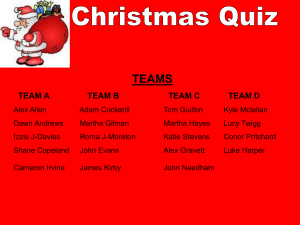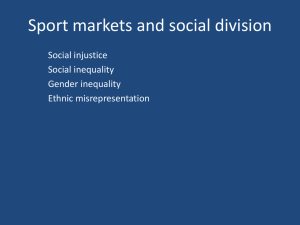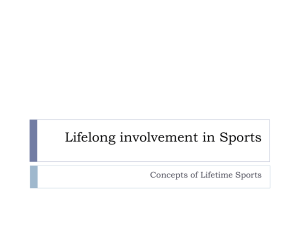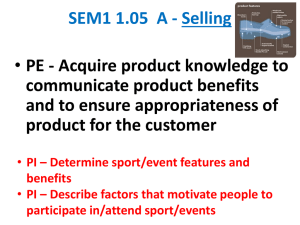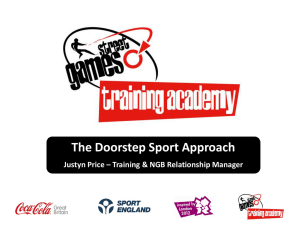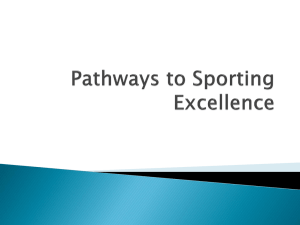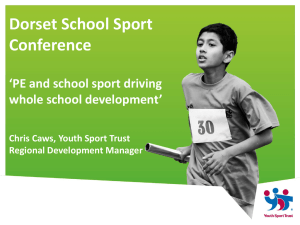GCSE PE Revision
advertisement
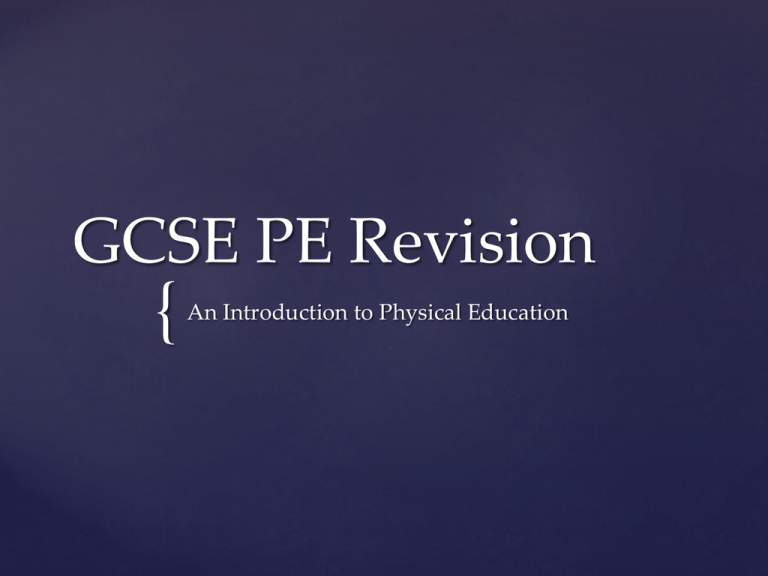
GCSE PE Revision
{
An Introduction to Physical Education
Competence
Performance
Creativity
Healthy, Active Lifestyles
Key Concepts
This involves the skills you learn and how you
apply them. It is also about how ready you are
in body and mind to perform them.
E.g. In football you should learn how to pass
E.g. Knowing when to shoot in basketball
In Netball not getting out of breath after 5 mins
Remember
S - Skills
A - Apply
R - Readiness
Competence
Producing effective outcomes when
participating in physical activities.
Performing well – being physically able and
having good skills
Knowing what is required to perform skills
well
E.g. read a game of football well and make a
successful pass at the right time
Performance
Exploring and experimenting with techniques,
tactics and ideas in order to do well.
Using your imagination
E.g. trying out different tactics in badminton to
see what works well
E.g. linking a set of skills together in a
imaginative way in gymnastics
Creativity
Understanding the purpose of physical activity
in making us healthy.
Understanding that exercise makes you fitter
and happier.
E.g. taking part in a regular hockey session
would make you fitter.
Healthy, Active Lifestyles
Running
Jumping
Throwing
Kicking
Hitting
Catching
Fundamental Motor Skills
Decisions made by:
Participants
Coaches/Leaders
Officials
Decision Making
Rules protect players, leaders and
officials.
If rules are followed accidents are less
likely to occur.
Rules ensure fair play.
Rules make the game more enjoyable.
Etiquette in sport is known as
sportsmanship. This is a code of
behaviour that compliments the rules.
Abiding by the rules,
etiquette and sportsmanship
Cardiovascular Endurance or
Stamina
Muscular Endurance
Speed
Strength
Flexibility
The Components of Fitness
and a Healthy Balanced
Lifestyle
Warm Up
Prepares the body and mind
for exercise.
Decreases the chance of injury.
Reduces the likelihood of
muscle soreness.
Increase in muscle temperature
helps ensure there is more
energy
And therefore muscles are
more flexible.
Improves speed and strength
of muscular contraction.
Cool Down
Speeds up removal of lactic acid.
Decreases the risk of injury.
Reduces the likelihood of muscle
soreness/aches.
Prevents blood pooling.
Prevents fatigue.
Prevents dizziness.
Gradually reduces heart
rate/breathing rate/temperature.
The Importance of Warming
Up and Cooling Down
Efficiency – not wasting energy
Pre-determined – knowing what you want to
achieve
Coordinated – linking things together well
Fluent – movements are flowing and smooth
Aesthetic – skills look good
E.g. A badminton serve beats the opponent and
lands inside the court
E.g. A gymnastics routine is fluent and coordinated
The Characteristics of
Skilful Movement
Setting goals:
Motivates people to exercise
Helps improve performance
Can increase confidence
Controls anxiety/worry
There are two types of goal:
Performance Goal
Outcome Goal
Goal Setting
Performance Goals
Relate directly to improving the
performance of the technique or tactic.
E.g. improve running technique in
sprinting
Outcome Goals
Are concerned with the end result.
E.g. to win a football match
Performance and
Outcome Goals
To assess whether someone is ready for exercise you must first assess
them.
One way is by Health Screening e.g.
BMI (testing the body mass index or body composition)
weight / height squared
Testing cholesterol, blood glucose and iron levels
Heart rate/resting heart rate – ideal is between 60 and 80
Blood pressure – normal is 120/80
Family history
Use a PARQ – Physical Activity Readiness Questionnaire
Assessing the Body’s
Readiness for Exercise
To assess whether someone is ready for exercise you must first assess
them.
Another way is by Fitness Testing e.g.
Assessing Cardiovascular Endurance or Stamina (test for V02 Max) –
Multistage Fitness Test or 12 Minute Cooper Run
Assessing Strength – Grip Strength Dynamometer (squeeze it as
hard as possible).
Assessing Speed – 30m Sprint
Assessing Flexibility – Sit and Reach Test
Tests must be reliable and valid – check equipment is working, make
sure it is measured accurately and consistently.
Assessing the Body’s
Readiness for Exercise
Carbohydrates –
Fats –
essential for good health e.g. calcium for healthy bones and teeth
found in dairy products such as milk
Water –
prevents disease and illness e.g. fruit
Minerals –
essential for growth and repair of tissue e.g. meat
Vitamins –
give us energy, protect vital organs e.g. cakes , oily fish
Proteins –
give us energy e.g. pasta
helps remove waste products, regulates body temperature, prevents
dizziness and fatigue
Fibre –
helps digestion e.g. cereal, vegetables
Components of a Healthy Diet
Eating a healthy, balanced diet
Maintaining a balance of food intake and
energy expenditure (exercise)
Regular exercise – government
recommends 1 hour on 5 or more days a
week
Maintaining a healthy body weight
Not Smoking
Sensible Alcohol Consumption
Maintain low levels of stress
Characteristics of a
Healthy Lifestyle
Age – discrimination, lack of confidence
Gender – stereotyping, discrimination, less women take part
Disability – lack of facilities, lack of confidence
Alcohol Consumption
Smoking – get out of breath, illnesses, less stamina
Over/Under Eating – too heavy, not enough energy, lack of
motivation
Performance Enhancing Drugs – addiction, depression,
disqualification, banned from sport, death
Factors Affecting Performance
and Participation
Satisfaction with Aspects of Life
Frequency of Positive and Negative Feelings
Frequency of Activities that have a Positive
Affect on Well-Being
Access to Green Space
Level of Participation in Activities
Positive Mental Health
Indicators of Health and
Well-Being
Circuit Training
Aerobics (Body Pump, Spinning, Dance Exercise)
Aqua Aerobics
Yoga
Pilates
Continuous Training
Methods of Exercise and
Training
3/4 adults have taken part in some sport, game or physical activity in the last 12 months.
In terms of participation the 5 most popular sports amongst adults in the UK are:
o
Walking 46%
o
Swimming 35%
o
Keep Fit/Yoga 22%
o
Cycling 19%
o
Cue Sports (Snooker/Pool) 17%
Participation rates by gender and age:
o
51% Men and 36% Women participate in regular exercise
o
44% Men and 31% Women belong to a sports club
o
40% Men and 14% Women enter sporting competitions
Women’s participation in football and rugby are now much higher than in the past and this is on the
rise.
The proportion of adults who take part in at least one sport generally decreases with age.
o
77% of 16 – 19 year olds take part in at least sport
o
30% of 70+ year olds take part in at least 1 sport
Participation in some activities is strongly related to age:
o
Soccer, cue sports, running and cycling are more popular amongst younger age groups
o
Golf is popular amongst adults with an average age of 42 but many adults up to 69 take part
o
Swimming/keep fit/yoga is popular amongst adults between 16 and 44 but this then declines
o
Bowls is popular amongst adults between 60 and 69 years old
Levels of Participation in the UK
Health Reasons
To manage stress
To feel good
To have a good sense of well-being
To live longer
To improve or maintain an image
For enjoyment
To meet new people or to make friends
As a hobby
To please or to copy parents or role models
To make money or as a job
Reasons for Participation
Health Reasons
Disability
Injury
Discrimination
Lack of Time/Other Pressures
Cultural
Peer Pressure
Technology
Lack of Confidence
Lack of encouragement or Positive Influences
Lack of Opportunities due to Facilities
Lack of Money
Reasons for Non-Participation
Access to facilities
Ethnicity
Religion
Environment
Climate
Cultural barriers
Funding barriers
Time
Resources
Peer Pressure
Social, Cultural and Locational
Reasons Affecting Participation
PE Lessons
Extra-Curricular Sports Clubs
Exam Courses e.g. GCSE PE
Links with Local Sports Clubs
The National Curriculum – it is compulsory
Health Awareness Programmes
Provides opportunities for children to follow the
key processes in physical education (as mentioned
earlier)
School Influences on
Participation
Regular involvement in PE, Sport and Dance
Take part in school and community sport and
dance opportunities
To gain a qualification as a performer, leader
or official
Being involved in challenging and complex
tasks
Reaching the highest possible standards
Pursuing routes into sport through
volunteering
Pathways for Involvement
in Physical Activity
